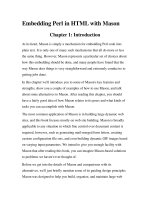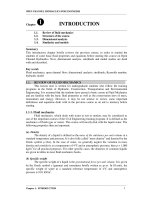Chapter 1 INTRODUCTION TO SUPPLY CHAIN MANAGEMENT
Bạn đang xem bản rút gọn của tài liệu. Xem và tải ngay bản đầy đủ của tài liệu tại đây (218.37 KB, 29 trang )
CHAPTER 1
INTRODUCTION TO SUPPLY
CHAIN MANAGEMENT
Principles of Supply Chain Management:
A Balanced Approach
Supply Chain Management:
The true story…
• Estimated that the grocery industry could save
$30 billion (10% of operating cost) by using
effective logistics and supply chain strategies
– A typical box of cereal spends 104 days from
factory to sale
– A typical car spends 15 days from factory to
dealership
• Compaq estimates it lost $0.5 billion to $1
billion in sales in 1995 because laptops were
not available when and where needed
• P&G estimates it saved retail customers $65
million by collaboration resulting in a better
match of supply and demand
MBA Nguyen Phi Hoang©2015_SCM
2
Recommended books
1. Principles of Supply Chain Management: A Balanced
Approach. 3rd E
( Author: Wisner, Leong and Tan,2012)
2. Essentials of Supply Chain Management
( Author: Michael Hugos)
3. Strategic Supply Chain Management
( Author: Cohen and Roussel)
4. Supply Chain Management: Best Practices
( Author: David Blanchard)
5. Operation & Supply Chain Management
( Author: Jacobs & Chase)
6. Supply Chain Excellence
( Author: Bolstorff and Rosenbaun)
MBA Nguyen Phi Hoang©2015_SCMu
3
Methods to learn this SCM
subject.
There are 14 chapters in Wisner’s SCM book
1. Introduction to SCM
2. Purchasing Management
3. Supplier relationship Management
4. Strategic sourcing for successful SCM
5. Collaborative, Planning, Forecasting & Replenishing
6. Enterprise Resource Planning System
7. Inventory management
8. Process Management(JIT, Lean, TQM)
9. Logistics Management
10. Customer Relationship Management
11. Location Management
12.Service response Logistics
13. Process Integration
14.Performance Measurement
MBA Nguyen Phi Hoang©2015_SCM
4
Learning Objectives
You should be able to:
• Describe a supply chain and define
supply chain management.
• Describe the objectives and elements of
supply chain management.
• Describe a brief history and some of the
trends of supply chain management.
MBA Nguyen Phi Hoang©2015_SCM
5
Chapter Outline
•
•
•
•
Introduction
Supply Chain Management Defined
The objectives of SCM
The Importance of Supply Chain
Management
• The Origins of Supply Chain
Management .
• The Foundations of Supply Chain
Management
• Some Current Trends in Supply Chain
Management
MBA Nguyen Phi Hoang©2015_SCM
6
What is a Supply Chain?
•
•
•
A supply chain consists of all stages involved, directly
or indirectly, in fulfilling a customer request. The
supply chain not only includes the manufacturer and
suppliers, but also transporters, warehouses, retailers,
and customers themselves – Chopra and Meindl
A supply chain is the alignment of firms that bring
products or services to market – Lambert, Stock, and
Ellram.
A supply chain is a network of facilities and
distribution options that performs the functions of
procurement of materials, transformation of these
materials into intermediate and finished products, and
the distribution of these finished products to
customers – Ganeshan and Harrison.
MBA Nguyen Phi Hoang©2015_SCM
7
What is a Supply Chain?(Cont.)
A supply chain consists of the flow of
products and services from:
–
–
–
–
–
Raw materials manufacturers
Component and intermediate manufacturers
Final product manufacturers
Wholesalers and distributors and
Retailers
Connected by transportation and storage
activities, and
Integrated through information, planning,
and integration activities
MBA Nguyen Phi Hoang©2015_SCM
8
What is a Supply Chain? (Cont.)
MBA Nguyen Phi Hoang©2015_SCM
9
Some more supply chain models
(cont.)
MBA Nguyen Phi Hoang©2015_SCM
10
Some more supply chain models
(cont.)
MBA Nguyen Phi Hoang©2015_SCM
11
What is Supply Chain Management?
The design and management of seamless, valueadded processes across organizational boundaries to
meet the real needs of the end customer
Institute for Supply Management
Managing supply and demand, sourcing raw materials
and parts, manufacturing and assembly, warehousing
and inventory tracking, order entry and order
management, distribution across all channels, and
delivery to the customer
The Supply Chain Council
The planning and management of all activities
involved in sourcing and procurement, conversion,
and all logistics management activities … also
includes coordination with channel partners, which
can be suppliers, intermediaries, third party service
providers, and customers.
Council of Supply Chain Management Professionals
MBA Nguyen Phi Hoang©2015_SCM
12
•
•
What is Supply Chain Management?
(Cont.)
Old paradigm - Firm gained synergy (strength
competitiveness) as a vertically integrated firm
encompassing the ownership and coordination of several
supply chain activities. Organizational cultures
emphasized short-term, company focused performance.
New paradigm - Firm in a supply chain focuses activities
in its area of specialization and enters into voluntary and
trust-based relationships with supplier and customer
firms.
– All participants in the supply chain benefit.
– Boundaries are dynamic and extend from “the firm’s
suppliers’ suppliers to its customers’ customers (i.e.,
second tier suppliers and customers).”
– Supply chains now deal with reverse logistics to handle
returned products, warranty repairs, and recycling.
MBA Nguyen Phi Hoang©2015_SCM
13
The Objectives of a Supply
Chain
• Ensure the uninterrupted flow of goods,
services and information throughout the
supply chain
• Lower supply chain cost
• Differentiate in satisfy customer’s needs.
• Allocate and maintain logically the
profits for all stages of the supply chain
Supply chain management is the
management of flows between and
among supply chain stages to maximize
total supply chain profitability
MBA Nguyen Phi Hoang©2015_SCM
14
Importance of Supply Chain
Management
Cost savings and better coordination of resources
are reasons to employ Supply Chain Management
– Reduced Bullwhip Effect- the magnified
reduction of safety stock costs based on
coordinated planning and sharing of
information
– Collaborative planning, forecasting, and
replenishment activities reduce the Bullwhip
Effect and lead to better customer service,
lower inventory costs, improved quality,
reduced cycle time, better production
methods, and other benefits.
MBA Nguyen Phi Hoang©2015_SCM
15
Importance of Supply Chain
Management (Cont.)
Firms have discovered value-enhancing
and long term benefits
Who benefits most? Firms with:
– Large inventories
– Large number of suppliers
– Complex products
– Customers with large purchasing budgets
Ex: In U.S
- Cost of purchased materials in 2008
: $3.2 trillion
- Cost of inventory among manufacturers : $2.2 trillion
- Transportation and inventory carrying cost : $434 Billion
MBA Nguyen Phi Hoang©2015_SCM
16
Origins of Supply Chain
Management
1950s & 1960s
U.S. manufacturers focused on mass
production techniques as their principal cost
reduction and productivity improvement
strategies
1960s-1970s
Introduction of new computer technology lead
to development of Materials Requirements
Planning (MRP) and Manufacturing Resource
Planning (MRPII) to coordinate inventory
management and improve internal
communication
MBA Nguyen Phi Hoang©2015_SCM
17
Origins of Supply Chain
Management (Cont.)
1980s & 1990s
Intense global competition led U.S.
manufacturers to adopt
Supply Chain Management along
with
Just-In-Time (JIT),
Total Quality Management (TQM),
and
Business Process Reengineering
(BPR) practices
MBA Nguyen Phi Hoang©2015_SCM
18
Origins of Supply Chain
Management –Cont.
2000s and Beyond
Industrial buyers will rely more on
third-party service providers (3PLs)
to improve purchasing and supply
management
Wholesalers/retailers will focus on
transportation and logistics more &
refer to these as quick response,
service response logistics, and
integrated logistics
MBA Nguyen Phi Hoang©2015_SCM
19
Origins of Supply Chain
Management –Cont.
MBA Nguyen Phi Hoang©2015_SCM
20
The Foundations of Supply
Chain Management
Supplier management, supplier
Supply
evaluation, supplier certification,
Management strategic partnerships, supplier alliance,
SRM, ethical & sustainable sourcing
Operations
Demand management, CPFR, Inventory
Management, MRP, ERP, JIT , lean
production, Six Sigma
Logistics
Logistics management, CRM, RFID,
distribution network, perfect order
fulfillment, global supply chains, service
response logistics
Integration
Barrier to integration, risk & security
management, green supply chain
MBA Nguyen Phi Hoang©2015_SCM
21
The Foundations of Supply
Chain Management (Cont.)
Supply or Purchasing Trends:
– Long term relationships
– Supplier management- improve
performance through
• Supplier evaluation (determining supplier
capabilities)
• Supplier certification (third party or internal
certification to assure product quality and service
requirements)
– Strategic partnerships- successful and
trusting relationships with top-performing
suppliers
MBA Nguyen Phi Hoang©2015_SCM
22
Important Elements of Supply
Chain Management
Operations Trends:
– Demand management- match
demand to available capacity
– Linking buyers & suppliers via MRP
and ERP systems
– Use JIT to improve the “pull” of
materials to reduce inventory levels
– Employ TQM to improve quality
compliance among suppliers
MBA Nguyen Phi Hoang©2015_SCM
23
Important Elements of Supply
Chain Management (Cont.)
Logistics Trends:
– Transportation management- tradeoff
decisions between cost & timing of
delivery/customer service via trucks, rail,
water & air
– Customer relationship managementstrategies to ensure deliveries, resolve
complaints, improve communications, &
determine service requirements
– Network design- creating distribution
networks based on tradeoff decisions
between cost & sophistication of
distribution system
MBA Nguyen Phi Hoang©2015_SCM
24
Important Elements of Supply
Chain Management (Cont.)
Integration Trends:
– Supply Chain Process Integrationwhen supply chain participants work
for common goals. Requires intra-firm
functional integration. Based on
efforts to change attitudes &
adversarial relationships
– Supply Chain Performance
Measurement- Crucial for firms to
know if procedures are working
MBA Nguyen Phi Hoang©2015_SCM
25









